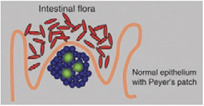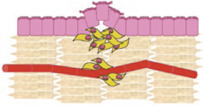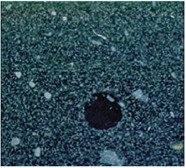Is oral tolerance induced locally?
Allan Mowat addresses the current hypotheses regarding the mechanisms of “oral tolerance” and discusses the challenge of determining the sites at which such tolerance is induced. See page 98
Intestinal effects of non-enteric viral infections
Many viral infections are thought to affect either the respiratory or gastrointestinal mucosa. In this issue, however, Peter Openshaw provides an insightful commentary on how respiratory viruses can cause enteric symptoms, and how classically non-enteric viruses can have enteric effects that are crucial for their pathogenesis. See page 100

Pathogenesis of lung remodeling and fibrosis
Pulmonary fibrosis and architectural remodeling of tissues can severely disrupt lung function, often with fatal consequences. This state-of-the-art review by Mark Wilson and Tom Wynn examines common mechanisms of pulmonary wound healing responses and highlights the pathogenesis of pulmonary fibrotic diseases. See page 103

Immunology of the larynx
Susan Thibeault and colleagues provide a unique perspective on the immunology of the larynx, an organ that is at the crossroads of the respiratory and gastrointestinal tracts and that is frequently the target of chronic inflammation. The authors also discuss the possible role of the larynx in immune regulation. See page 122
Novel lipopeptide vaccine against HSV-2
Xiuli Zhang and colleagues demonstrate the feasibility of a novel vaccine approach using a lipid-modified conjugate helper and cytotoxic T-cell peptide vaccine that targets Toll-like receptor 2. Vaginal delivery of a herpes simplex virus type 2 (HSV-2) modified lipopeptide elicited effective CD8 T-cell responses and protection against HSV-2 challenge. See page 129
Suppression of airway allergy by acute gut parasite infection
Experimental evidence supports the hypothesis that chronic intestinal helminth infection can suppress allergen-induced airway responses and pathology. Deena Gibbons and colleagues demonstrate that acute intestinal parasite infection can suppress responses to coadministered allergens at distant sites by a mechanism that is dependent on interferon-γ. See page 144
Are gut-migrating DCs “tolerogenic”?
Dendritic cells (DCs) are known to migrate in the steady state from the intestine to mesenteric lymph nodes, where they are thought to contribute to the induction of regulatory T cells specific for gut antigens. Simon Milling and colleagues challenge this notion by demonstrating that DCs collected directly from the thoracic duct lymph following mesenteric lymph adenectomy induce potent inflammatory responses in naive CD4+ T cells. See page 156
Probiotics induce β-defensin production in humans
Antimicrobial activity in epithelial cells is mediated in part by β-defensins. M. Möndel and colleagues demonstrate that administration of a cocktail of selected E. coli strains to healthy individuals results in increased antimicrobial human β-defensin 2 production in the intestine. See page 166

CCR6 in Th17 trafficking
CCR6 is universally expressed on T helper 17 (Th17) cells, but its role in migration to the intestine is not clear. Chuanwu Wang and colleagues present data supporting the hypothesis that Th17 cells preferentially migrate to the intestine and associated lymphoid tissues. Furthermore, CCR6 is important for localization to certain tissues, such as Peyer's patches, and may have a role in effector T-cell balance in the inflamed intestine. See page 173


